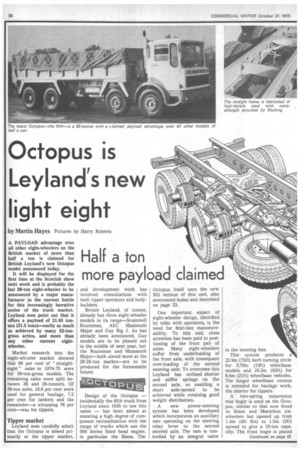Octopus is Leyland's new light eight
Page 32

If you've noticed an error in this article please click here to report it so we can fix it.
by Martin Hayes Pictures by Harry Roberts A PAYLOAD advantage over all other eight-wheelers on the British market of more than half a ton is claimed for British Leyland's new Octopus model announced today.
It will be displayed for the first time at the Scottish show next week and is probably the last 30-ton eight-wheeler to be announced by a major manufacturer in the current battle for this increasingly lucrative sector of the truck market. Leyland men point out that it offers a payload of 21.85 tonnes (21.5 tons)—easily as much as achieved by many 32-tongross artics, and more than any other current eightwheeler.
Market research into the eight-whceler market showed that 90 per cent of " straighteight " sales in 1974-75 were for 30-ton-gross models. The remaining sales were split between 26 and 28-tonners. Of 30-ton sales, 16.8 per cent were used for general haulage, 7.2 per cent for tankers and the remainder—a whopping 76 per cent—was for tippers.
Tipper market
Leyland men candidly admit that the Octopus is aimed primarily at the tipper market, and development work has involved consultations with both tipper operators and bodybuilders.
British Leyland, of course, already has three eight-wheeler models in its range—Scammell Routeman, AEC Mammoth Major and Guy Big J. As has already been announced, Guy models are to be phased out in the middle of next year, but the Routeman and Mammoth Major—both aimed more at the 26-28-ton market—are to be produced for the foreseeable future.
































































































